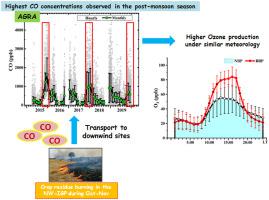Atmospheric Pollution Research ( IF 4.5 ) Pub Date : 2021-08-07 , DOI: 10.1016/j.apr.2021.101166 Sonal Kumari 1 , Anita Lakhani 1 , K. Maharaj Kumari 1

|
In the present study the diurnal, seasonal variability along with the comparison of ground-based and satellite retrieved carbon monoxide (CO) observations are reported at Agra. In addition, the impact of long-range transport of emissions from crop residue burning region (Punjab and Haryana) on CO concentrations at a downwind site was determined. Previous studies reported so far in India have mainly focused on the impact of crop residue burning activities on CO concentrations in the nearby regions while the present study is an attempt to identify the impact of these activities on a downwind site situated several kilometers away. The average concentration of in-situ measured CO at Agra was 518.7 ± 487.9 ppb during 2015–2019. A good correlation between ground-based and satellite CO observations was found (y = 0.1 x + 129.4, R = 0.8). The highest seasonal average CO concentrations were observed during Oct–Nov, which corresponds with paddy residue burning in the north-west IGP (NW-IGP). These activities result in the emission of CO which can be transported to distant places due to its long lifetime (2 months) and can influence the air quality. It was observed that during the crop residue burning period the average concentrations of CO were higher by 19.8, 78.7 and 65.1 %, respectively in 2015, 2017 and 2019. Backward air mass trajectories and potential source contribution function (PSCF) suggested crop residue burning activities can be the potential source of CO at the study site during the crop residue burning period.
中文翻译:

印度恒河平原郊区一氧化碳的变化:作物残茬燃烧区远距离迁移的影响
在本研究中,阿格拉报告了昼夜、季节性变化以及地面和卫星检索到的一氧化碳 (CO) 观测结果的比较。此外,还确定了作物残留物燃烧区(旁遮普邦和哈里亚纳邦)排放物的远距离迁移对顺风地点的 CO 浓度的影响。迄今为止在印度报道的先前研究主要集中在作物残留物燃烧活动对附近地区 CO 浓度的影响,而本研究试图确定这些活动对位于几公里外的下风地点的影响。2015-2019 年期间,阿格拉原位测量的 CO 平均浓度为 518.7 ± 487.9 ppb。发现地面和卫星 CO 观测之间存在良好的相关性(y = 0.1 x + 129.4,R = 0.8)。在 10 月至 11 月期间观察到最高的季节性平均 CO 浓度,这与西北 IGP (NW-IGP) 的稻谷残渣燃烧相对应。这些活动会导致 CO 的排放,由于其使用寿命长(2 个月),CO 可以运输到很远的地方,并会影响空气质量。据观察,2015、2017 和 2019 年,农作物秸秆焚烧期间 CO 的平均浓度分别高出 19.8、78.7 和 65.1%。后向气团轨迹和潜在源贡献函数(PSCF)表明农作物秸秆燃烧活动在作物残茬燃烧期间,可能是研究地点 CO 的潜在来源。这些活动会导致 CO 的排放,由于其使用寿命长(2 个月),CO 可以运输到遥远的地方,并会影响空气质量。据观察,2015、2017 和 2019 年,农作物秸秆焚烧期间 CO 的平均浓度分别高出 19.8、78.7 和 65.1%。后向气团轨迹和潜在源贡献函数(PSCF)表明农作物秸秆燃烧活动在作物残茬燃烧期间,可能是研究地点 CO 的潜在来源。这些活动会导致 CO 的排放,由于其使用寿命长(2 个月),CO 可以运输到遥远的地方,并会影响空气质量。据观察,2015 年、2017 年和 2019 年,农作物秸秆焚烧期间 CO 的平均浓度分别高出 19.8、78.7 和 65.1%。后向气团轨迹和潜在源贡献函数(PSCF)表明农作物秸秆焚烧活动在作物残茬燃烧期间,可能是研究地点 CO 的潜在来源。


























 京公网安备 11010802027423号
京公网安备 11010802027423号